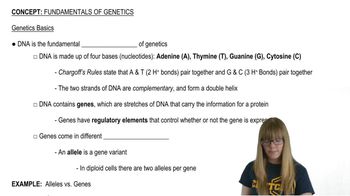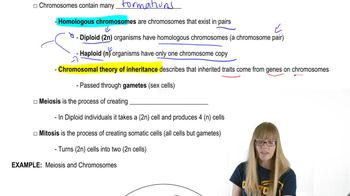Table of contents
- 1. Introduction to Genetics51m
- 2. Mendel's Laws of Inheritance3h 37m
- 3. Extensions to Mendelian Inheritance2h 41m
- 4. Genetic Mapping and Linkage2h 28m
- 5. Genetics of Bacteria and Viruses1h 21m
- 6. Chromosomal Variation1h 48m
- 7. DNA and Chromosome Structure56m
- 8. DNA Replication1h 10m
- 9. Mitosis and Meiosis1h 34m
- 10. Transcription1h 0m
- 11. Translation58m
- 12. Gene Regulation in Prokaryotes1h 19m
- 13. Gene Regulation in Eukaryotes44m
- 14. Genetic Control of Development44m
- 15. Genomes and Genomics1h 50m
- 16. Transposable Elements47m
- 17. Mutation, Repair, and Recombination1h 6m
- 18. Molecular Genetic Tools19m
- 19. Cancer Genetics29m
- 20. Quantitative Genetics1h 26m
- 21. Population Genetics50m
- 22. Evolutionary Genetics29m
1. Introduction to Genetics
Fundamentals of Genetics
Problem 5
Textbook Question
Define the terms allele, chromosome, and gene, and explain how they relate to one another. Develop an analogy between these terms and the process of using a street map to locate a new apartment to live in next year (i.e., consider which term is analogous to a street, which to a type of building, and which to an apartment floor plan).
 Verified step by step guidance
Verified step by step guidance1
Step 1: Define the term 'gene'. A gene is a segment of DNA that contains the instructions for the synthesis of a specific protein or set of proteins. It is the basic unit of heredity and is responsible for the inherited traits in an organism.
Step 2: Define the term 'allele'. An allele is a variant form of a gene. Different alleles can result in different traits, such as eye color or blood type. Each individual inherits two alleles for each gene, one from each parent.
Step 3: Define the term 'chromosome'. A chromosome is a long, continuous thread of DNA that contains many genes. Humans have 23 pairs of chromosomes, which are found in the nucleus of each cell.
Step 4: Explain the relationship between genes, alleles, and chromosomes. Genes are located on chromosomes, and alleles are different versions of these genes. Chromosomes serve as the structure that organizes and carries genes within the cell.
Step 5: Develop an analogy using a street map. In this analogy, a chromosome is like a street, a gene is like a type of building on that street, and an allele is like the specific floor plan of an apartment within that building. Just as different buildings can have different floor plans, different genes can have different alleles.
Recommended similar problem, with video answer:
 Verified Solution
Verified SolutionThis video solution was recommended by our tutors as helpful for the problem above
Video duration:
2mPlay a video:
Was this helpful?
Key Concepts
Here are the essential concepts you must grasp in order to answer the question correctly.
Allele
An allele is a variant form of a gene that arises by mutation and is found at the same place on a chromosome. Alleles can be dominant or recessive, influencing the traits expressed in an organism. In the analogy, an allele can be compared to a specific street name on a map, representing a particular variation of a location.
Recommended video:
Guided course

New Alleles and Migration
Chromosome
A chromosome is a long, thread-like structure made of DNA and proteins that contains many genes. Humans typically have 23 pairs of chromosomes, which carry the genetic information necessary for development and functioning. In the analogy, a chromosome can be likened to the entire street grid on a map, encompassing various streets (alleles) and buildings (genes) within a defined area.
Recommended video:
Guided course

Chromosome Structure
Gene
A gene is a segment of DNA that contains the instructions for building proteins, which determine the traits of an organism. Genes are the basic units of heredity and can exist in different forms (alleles). In the analogy, a gene can be compared to a specific building type on a street, representing a particular characteristic or function within the broader context of the chromosome (street grid).
Recommended video:
Guided course

Mapping Genes

 8:55m
8:55mWatch next
Master Genetics Basics with a bite sized video explanation from Kylia Goodner
Start learning



